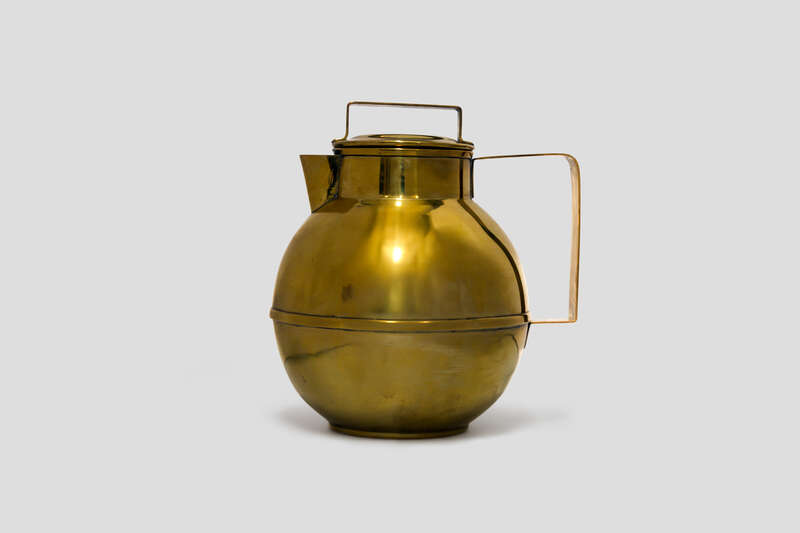Home > Advanced search > Objects > Brass jug
Brass jug
Ferdinand Kramer; Emil Graf
1923 - 1924
Title
Brass jug
Involved in the execution
Ferdinand Kramer (Design) GND
Emil Graf (Production)
Date
1923 - 1924 (Production)
Geographical reference
Place of production: Frankfurt am Main
Material / Technique
Brass, cut, soldered, polished; series production
Object type
Collection
Inventory number
19049
Creditline
Museum Angewandte Kunst, Frankfurt am Main
Included in these topics
- Key: 6fb1c529-37cb-4ed0-b139-47d5784a6ef7
- Module_ref: collection
- Create_date: 2021-01-15T12:09:26Z
- Change_date: 2025-09-15T22:00:00Z
- Sync_date: 2025-12-14T21:47:57Z
- Container_S: Design
- InventoryNumber_S: 19049
- InventoryNumber_S_sort: 19049
- SimpleSearch: 19049,1923 - 1924,Brass, cut, soldered, polished; series production,New Frankfurt, Industrial design, Gloss,Ferdinand,Kramer;;Emil Graf,Ewers,Messingkanne,Brass jug,Europe/Germany/Hesse/Frankfurt am Main,Europe;;Germany;;Hesse;;Frankfurt am Main,Brass,Cutting (shaping or dividing),Brazing,Polishing,Kramer,Ferdinand,Kramer Ferdinand,Frankfurt am Main,Frankfurt am Main,Emil Graf,Emil Graf,Frankfurt am Main,Bauchige Kanne aus Messing mit Deckel
- SimpleSearch2: 19049,1923 - 1924,Brass, cut, soldered, polished; series production,New Frankfurt, Industrial design, Gloss,Ferdinand,Kramer;;Emil Graf,Ewers,Messingkanne,Brass jug,Europe/Germany/Hesse/Frankfurt am Main,Europe;;Germany;;Hesse;;Frankfurt am Main,Brass,Cutting (shaping or dividing),Brazing,Polishing,Kramer,Ferdinand,Kramer Ferdinand,Frankfurt am Main,Frankfurt am Main,Emil Graf,Emil Graf,Frankfurt am Main,Bauchige Kanne aus Messing mit Deckel
- InventoryNumberSearch_S: 19049
- IvNO_S: 19049
- AcquisitionDate_S: 31.12.2021
- MainTitle_S: Brass jug
- MainTitle_S_sort: Brass jug
- DatingType_S: Herstellung | Production
- Dating_S: 1923 - 1924
- Dating_S2: 1923 - 1924
- YearFrom_I: 1923
- YearTo_I: 1924
- Copyright_S: © KRAMER ARCHIV
- Creditline_S: Museum Angewandte Kunst, Frankfurt am Main
- Systematic_S: Design
- Systematic_multi_facet: Design
- Systematic_multi_facet_filter: Design
- MaterialTechnique_S: Brass, cut, soldered, polished; series production
- Keywords_S: New Frankfurt, Industrial design, Gloss
- Keywords_multi_facet: New Frankfurt;;Industrial design;;Gloss
- Keywords_multi_facet_filter: New Frankfurt;;Industrial design;;Gloss
- Materials_multi_facet: Brass
- Materials_multi_facet_filter: Brass
- Techniques_multi_facet: Cutting (shaping or dividing);;Brazing;;Polishing
- Techniques_multi_facet_filter: Cutting (shaping or dividing);;Brazing;;Polishing
- Subjects_FirstName_multi_facet: Ferdinand
- Subjects_FirstName_multi_facet_filter: Ferdinand
- Subjects_Name_multi_facet: Kramer;;Emil Graf
- Subjects_Name_multi_facet_filter: Kramer;;Emil Graf
- Subjects_FullName_multi_facet: Ferdinand Kramer;;Emil Graf
- Subjects_FullName_multi_facet_filter: Ferdinand Kramer;;Emil Graf
- Subjects_NameSorted_multi_facet: Kramer, Ferdinand;;Emil Graf
- Subjects_NameSorted_multi_facet_filter: Kramer, Ferdinand;;Emil Graf
- lists_s: ObjectNames,Titles,GeographicReferences,Materials,Techniques,Datings,Subjects,Texts,Dimensions,WebLinks,Media
- list_ObjectNames_I: 1
- ObjectNames_Type_0_S: Obj.bez.
- ObjectNames_Text_0_S: Ewers
- list_Titles_I: 2
- Titles_Type_0_S: Titel
- Titles_Text_0_S: Messingkanne
- Titles_Text_S_sort: Messingkanne
- TitleSearch: Messingkanne,Brass jug
- Titles_Type_1_S: Titel (englisch)
- Titles_Text_1_S: Brass jug
- list_GeographicReferences_I: 1
- GeographicReferences_Type_0_S: Herstellungsort | Place of production
- GeographicReferences_Text_0_S: Europe/Germany/Hesse/Frankfurt am Main
- GeographicReferences_Text_0_multi_facet: Europe;;Germany;;Hesse;;Frankfurt am Main
- GeographicReferences_Text_0_multi_facet_filter: Europe;;Germany;;Hesse;;Frankfurt am Main
- list_Materials_I: 1
- Materials_Type_0_S: Material
- Materials_Text_0_S: Brass
- list_Techniques_I: 3
- Techniques_Type_0_S: Technik
- Techniques_Text_0_S: Cutting (shaping or dividing)
- Techniques_Type_1_S: Technik
- Techniques_Text_1_S: Brazing
- Techniques_Type_2_S: Technik
- Techniques_Text_2_S: Polishing
- list_Datings_I: 0
- list_Subjects_I: 2
- Subjects_Role_0_S: Design
- Subjects_Key_0_S: 40706f9f-39b0-49cf-9309-f5ff0fa33e4e
- Subjects_Type_0_S: Person
- Subjects_Name_0_S: Kramer
- Subjects_FirstName_0_S: Ferdinand
- Subjects_SortedName_0_S: Kramer Ferdinand
- Subjects_S_sort: Kramer Ferdinand
- Subjects_Dating_0_S: 1898 - 1985
- Subjects_PlaceOfBirth_0_S: Frankfurt am Main
- Subjects_PlaceOfDeath_0_S: Frankfurt am Main
- Subjects_DayOfBirth_0_S: 22.01.1898
- Subjects_DayOfDeath_0_S: 04.11.1985
- Subjects_UriGnd_0_S: http://d-nb.info/gnd/118566083
- Subjects_Role_1_S: Production
- Subjects_Key_1_S: 37d563c6-3a26-4468-a0d9-95facf96fc7a
- Subjects_Type_1_S: Körperschaft
- Subjects_Name_1_S: Emil Graf
- Subjects_SortedName_1_S: Emil Graf
- Subjects_PlaceOfBirth_1_S: Frankfurt am Main
- list_Texts_I: 0
- list_Dimensions_I: 0
- list_WebLinks_I: 0
- list_Media_I: 1
- Media_Key_0_s: a37421ee-bb85-4377-9770-10f06062d18b
- Media_Type_0_S: Bild
- Media_AltText_0_S: Bauchige Kanne aus Messing mit Deckel
- Media_Rightsholder_0_S: Museum Angewandte Kunst
- Media_Credits_0_S: Foto: Ute Kunze © Museum Angewandte Kunst
- _version_: 1851522788064493600
- lists: [object Object]



